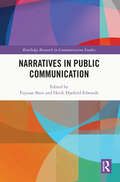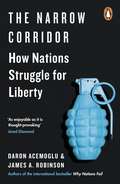- Table View
- List View
Narrative Organisationsentwicklung: Ein Arbeitsbuch in Fallbeispielen
by Christine Erlach Michael MüllerDie Narrative Organisationsentwicklung ist ein relativ neues Paradigma, das jedoch zunehmend Eingang in Change-, Strategie-, Kommunikations-, Wissensmanagement- und Entwicklungsprozesse in Unternehmen findet. Die Prämisse dahinter ist, dass Sinn (Purpose), Werte, Identität, Wissen und Kommunikation von Unternehmen wesentlich durch narrative Strukturen (Geschichten und Erzählungen) definiert, entwickelt und weitergegeben werden.Dieser Band versammelt Fallbeispiele, in denen narrative Ansätze und Methoden in der Organisationsentwicklung von Praktiker*innen angewendet wurden. Sie dienen als Anregung, in der eigenen Organisation mit narrativen Herangehensweisen zu arbeiten. Jedes Fallbeispiel ist so anschaulich und transparent erzählt, dass der/die Leser*in Methoden, Strategien und Abläufe an den Bedarf der eigenen Organisation oder des eigenen Projektes anpassen kann. Der Band ist ein Arbeitsbuch, das Ideen gibt und Methoden in ihrer Anwendbarkeit transparent macht – und so den Leser*innen den Einstieg in die Narrative Organisationsentwicklung und -beratung erleichtert.Die Idee des Buches entstand im Rahmen der ersten europäischen Fortbildung in der "Narrativen Organisationsberatung"; die Fallarbeiten der Teilnehmenden zur Zertifizierung in der Fortbildung, die sie in ihren Herkunftsorganisationen durchgeführt haben, bilden den Grundstock dieses Buches. Ergänzt wurde es durch Fälle weiterer Alumni der Fortbildungen der Herausgeber*innen sowie erfahrener Praktiker*innen in der narrativen Organisationsentwicklung.
Narrative Organizations: Making Companies Future Proof by Working With Stories (Management for Professionals)
by Michael Müller Christine ErlachThis book shows how to work with stories and narrative approaches in almost all fields of action of a company, and demonstrates the added value resulting from a holistic narrative perspective. The authors take thereby a practice-based perspective from the viewpoint of managing directors, the C-suite, organizational developers, corporate communicators and advisers with a rich description of the methods and implementation.By the employment of these narrative methods, leadership styles, communication, knowledge and change management can be planned in such a way that on the one hand the identity-core of the enterprise remains always apparent and on the other, the organization can develop in an agile fashion into the future.
Narrative Praktiken von Unternehmen: Imagefördernde Selbstdarstellungen im Internet
by Ulrike AckermannDiese Open-Access-Publikation befasst sich mit dem Erzählen im Unternehmenskontext, was spätestens seit der Einführung des Storytelling in den 1999er-Jahren allgegenwärtig ist. Der Band zeigt in diesem Zusammenhang, wie Unternehmen das Erzählen explizit im Internet nutzen, um sich nach außen positiv darzustellen (= Imageförderung). In der Veröffentlichung wird deutlich, dass für die (Selbst)Darstellung bestimme Spezifika von Erzählungen von besonderer Bedeutung sind. Mit ihrer Hilfe können Unternehmen bspw. Konzepte – wie Corporate Responsibility – als gelebte Werte den Zielgruppen diskret veranschaulichen oder den Arbeitsalltag zu einem besonderen Erlebnis stilisieren. Insgesamt identifiziert die Autorin vier Grundtypen der (Selbst)Darstellung mit jeweils spezifisch narrativer Rhetorik sowie bezeichnende narrative Realisierungsformen, um diese Typen im WWW an die gewünschten Zielgruppen zu kommunizieren. Hierbei zeichnen sich die sprachwissenschaftlich analysierten Erkenntnisse durch ihre interdisziplinäre Einbettung aus. Dadurch eröffnen sich Anschlussmöglichkeiten zu anderen Fachdisziplinen.
Narrative Strategies in Television Series
by G. Allrath M. GymnichIn the context of a systematic overview of the possibilities of applying narratological concepts to a study of TV series, ten case studies are explored in depth, demonstrating how series such as 24, Buffy, Twin Peaks, Star Trek, Blackadder, and Sex and the City make use of innovative audiovisual means of storytelling. Transgressing the traditional confines of narrative theory, the chapter authors address the question of how form, content, and function intersect in these series.
Narratives in Public Communication (Routledge Research in Communication Studies)
by Fuyuan Shen Heidi Hatfield EdwardsThis volume explores the applications of narrative and storytelling in corporate, public health, and political communications, and its implications for those fields. Using diverse research methods including surveys, experiments, case studies, and content analyses, an international team of authors first explore conceptual and theoretical issues of narrative persuasion, then examine the impact and application of narratives in science communication, political advertising, corporate communication, and social movement before discussing the use of stories in community building, identity construction, and civic engagement. This timely volume will be of interest to academics, researchers, and graduate students who are interested in narratives and communications, within the areas of public relations, public communication, organizational communication, strategic communication, risk and crisis communication, and political communication.
Narratives in Public Communication (Routledge Research in Communication Studies)
This volume explores the applications of narrative and storytelling in corporate, public health, and political communications, and its implications for those fields. Using diverse research methods including surveys, experiments, case studies, and content analyses, an international team of authors first explore conceptual and theoretical issues of narrative persuasion, then examine the impact and application of narratives in science communication, political advertising, corporate communication, and social movement before discussing the use of stories in community building, identity construction, and civic engagement. This timely volume will be of interest to academics, researchers, and graduate students who are interested in narratives and communications, within the areas of public relations, public communication, organizational communication, strategic communication, risk and crisis communication, and political communication.
Narratives of Architectural Education: From Student to Architect (Routledge Research in Architecture)
by James ThompsonNarratives of Architectural Education provides an overview of life as an architecture student, detailing how a layperson may develop an architectural identity. This book proposes becoming an architect as a personal narrative of professional development structured around various stages and challenges associated with identity transformation. Using a case study of aspiring architects along multiple time points of their professional education, Thompson investigates the occupational identity of architects; how individuals construct a sense of themselves as future architects and position themselves within the architectural community. This book provides previously unexamined insights into not just the academic development of an architect, but also the holistic and experiential aspects of architectural education. It would be ideal for those in the educational field of architecture, to include students, educators, interns, and mentors.
Narratives of Architectural Education: From Student to Architect (Routledge Research in Architecture)
by James ThompsonNarratives of Architectural Education provides an overview of life as an architecture student, detailing how a layperson may develop an architectural identity. This book proposes becoming an architect as a personal narrative of professional development structured around various stages and challenges associated with identity transformation. Using a case study of aspiring architects along multiple time points of their professional education, Thompson investigates the occupational identity of architects; how individuals construct a sense of themselves as future architects and position themselves within the architectural community. This book provides previously unexamined insights into not just the academic development of an architect, but also the holistic and experiential aspects of architectural education. It would be ideal for those in the educational field of architecture, to include students, educators, interns, and mentors.
Narratives of Crisis: Telling Stories of Ruin and Renewal (High Reliability and Crisis Management)
by Timothy L. Sellnow Matthew SeegerHow did you first hear about 9/11? What images come to mind when you think of Hurricane Katrina? How did your community react to the Sandy Hook Elementary School shooting? You likely have your own stories about these tragic events. Yet, as a society, we rarely stop to appreciate the narratives that follow a crisis and their tremendous impact. This book examines the fundamental role that narratives play in catastrophic events. A crisis creates a communication vacuum, which is then populated by the stories of those who were directly affected, as well as crisis managers, journalists, and onlookers. These stories become fundamental to how we understand a disaster, determine what should be done about it, and carry forward our lessons learned. Matthew W. Seeger and Timothy L. Sellnow outline a typology of crisis narratives: accounts of blame, stories of renewal, victim narratives, heroic tales, and memorials. Using cases to illustrate each type, they show how competing accounts battle for dominance in the public sphere, advancing specific organizational, social, and political changes. Narratives of Crisis improves our understanding of how consensus forms in the aftermath of a disaster, providing a new lens for comprehending events in our past and shaping what comes from those in our future.
Narratives of Drunkenness: Belgium, 1830–1914 (Perspectives in Economic and Social History)
by An VleugelsFocusing on Belgium from the mid-nineteenth century until the First World War, Vleugels presents a study of the drunkard in society.
Narratives of Drunkenness: Belgium, 1830–1914 (Perspectives in Economic and Social History #25)
by An VleugelsFocusing on Belgium from the mid-nineteenth century until the First World War, Vleugels presents a study of the drunkard in society.
Narratives of Learning Through International Professional Experience
by Ange Fitzgerald Graham Parr Judy WilliamsThis book presents a collection of research-based narratives exploring the learning of pre-service teachers and teacher educators in a range of international professional experience (IPE) settings. The narratives, based on over 20 years of IPE managed by an Australian faculty of education, capture the lessons learnt from the IPE program from a variety of perspectives, including academic staff, pre-service teachers and in-country partners. Four key themes emerge from the narratives: identity, learning through discomfort, collaboration and relationships. At a time when critics of teacher education are arguing for more predictable, standardised programs and practices, this book advocates for richly diverse, innovative programs that better prepare the next generation of educators for teaching in a multicultural, uncertain future.
Narratives of Travel and Tourism
by Jacqueline Tivers Tijana RakiĆTravel and tourism 'stories' have been told and recorded within every culture, in every period of oral and written history, and across the breadth of the fact/fiction continuum. Taking two broad themes as its starting point - travellers and their narratives, and place narratives in travel and tourism - the book has a deliberately wide scope, with different chapters addressing the subject through various relevant 'lenses' and in relation to a number of different contexts. The narratives discussed include both historical and contemporary, as well as 'real-life' and fictional, narratives contained within travel writing, travel and tourism stories and different types of media. In relation to the principal themes of the book, some chapters also explore the importance of collecting memorabilia and image making in the recording, remembering, writing, telling or disseminating of stories about travel and tourism experiences and some examine the ways in which travel and tourism narratives may construct and reinforce personal, collective and place identities. The whole book is marked by an over-arching concern for narrative interpretation as a means of understanding, and providing a new perspective on, travel and tourism.
Narratives of Travel and Tourism
by Jacqueline Tivers Tijana RakicTravel and tourism 'stories' have been told and recorded within every culture, in every period of oral and written history, and across the breadth of the fact/fiction continuum. Taking two broad themes as its starting point - travellers and their narratives, and place narratives in travel and tourism - the book has a deliberately wide scope, with different chapters addressing the subject through various relevant 'lenses' and in relation to a number of different contexts. The narratives discussed include both historical and contemporary, as well as 'real-life' and fictional, narratives contained within travel writing, travel and tourism stories and different types of media. In relation to the principal themes of the book, some chapters also explore the importance of collecting memorabilia and image making in the recording, remembering, writing, telling or disseminating of stories about travel and tourism experiences and some examine the ways in which travel and tourism narratives may construct and reinforce personal, collective and place identities. The whole book is marked by an over-arching concern for narrative interpretation as a means of understanding, and providing a new perspective on, travel and tourism.
The Narrow Corridor: States, Societies, and the Fate of Liberty
by Daron Acemoglu James A. Robinson'A must-read. Acemoglu and Robinson are intellectual heavyweights of the first rank . . . erudite and fascinating' Paul Collier, Guardian, on Why Nations FailBy the authors of the international bestseller Why Nations Fail, based on decades of research, this powerful new big-picture framework explains how some countries develop towards and provide liberty while others fall to despotism, anarchy or asphyxiating norms- and explains how liberty can thrive despite new threats.Liberty is hardly the 'natural' order of things; usually states have been either too weak to protect individuals or too strong for people to protect themselves from despotism. There is also a happy Western myth that where liberty exists, it's a steady state, arrived at by 'enlightenment'. But liberty emerges only when a delicate and incessant balance is struck between state and society - between elites and citizens. This struggle becomes self-reinforcing, inducing both state and society to develop a richer array of capacities, thus affecting the peacefulness of societies, the success of economies and how people experience their daily lives.Explaining this new framework through compelling stories from around the world, in history and from today - and through a single diagram on which the development of any state can be plotted - this masterpiece helps us understand the past and present, and analyse the future.'An intellectually rich book that develops an important thesis with verve' Martin Wolf, Financial Times, on Why Nations Fail
Narrowing the Channel: The Politics of Regulatory Protection in International Trade (Chicago Series on International and Domestic Institutions)
by Robert GulottyWhile large, multinational corporations have supported the removal of tariffs, behind the scenes these firms have fought for protection in the form of product regulations, including testing, labeling, and registration requirements. Unlike tariffs, these regulations can raise fixed costs, excluding smaller firms from the market and shifting profits toward global giants. Narrowing the Channel demonstrates that globalization and globalized firms can paradoxically hinder rather than foster economic cooperation as larger firms seek to protect their markets through often unnecessarily strict product regulations. To illustrate the problem of regulatory protectionism, Robert Gulotty offers an in-depth analysis of contemporary rulemaking in the United States and the European Union in the areas of health, safety, and environmental standards. He shows how large firms seek regulatory schemes that disproportionately disadvantage small firms. When multinationals are embedded in the local economy, governments too have an incentive to use these regulations to shift profits back home. Today, the key challenge to governing global trade is not how much trade occurs but who is allowed to participate, and this book shows that new rules will be needed to allow governments to widen the benefits of global commerce and avoid further inequality and market concentration.
Narrowing the Channel: The Politics of Regulatory Protection in International Trade (Chicago Series on International and Domestic Institutions)
by Robert GulottyWhile large, multinational corporations have supported the removal of tariffs, behind the scenes these firms have fought for protection in the form of product regulations, including testing, labeling, and registration requirements. Unlike tariffs, these regulations can raise fixed costs, excluding smaller firms from the market and shifting profits toward global giants. Narrowing the Channel demonstrates that globalization and globalized firms can paradoxically hinder rather than foster economic cooperation as larger firms seek to protect their markets through often unnecessarily strict product regulations. To illustrate the problem of regulatory protectionism, Robert Gulotty offers an in-depth analysis of contemporary rulemaking in the United States and the European Union in the areas of health, safety, and environmental standards. He shows how large firms seek regulatory schemes that disproportionately disadvantage small firms. When multinationals are embedded in the local economy, governments too have an incentive to use these regulations to shift profits back home. Today, the key challenge to governing global trade is not how much trade occurs but who is allowed to participate, and this book shows that new rules will be needed to allow governments to widen the benefits of global commerce and avoid further inequality and market concentration.
Narrowing the Channel: The Politics of Regulatory Protection in International Trade (Chicago Series on International and Domestic Institutions)
by Robert GulottyWhile large, multinational corporations have supported the removal of tariffs, behind the scenes these firms have fought for protection in the form of product regulations, including testing, labeling, and registration requirements. Unlike tariffs, these regulations can raise fixed costs, excluding smaller firms from the market and shifting profits toward global giants. Narrowing the Channel demonstrates that globalization and globalized firms can paradoxically hinder rather than foster economic cooperation as larger firms seek to protect their markets through often unnecessarily strict product regulations. To illustrate the problem of regulatory protectionism, Robert Gulotty offers an in-depth analysis of contemporary rulemaking in the United States and the European Union in the areas of health, safety, and environmental standards. He shows how large firms seek regulatory schemes that disproportionately disadvantage small firms. When multinationals are embedded in the local economy, governments too have an incentive to use these regulations to shift profits back home. Today, the key challenge to governing global trade is not how much trade occurs but who is allowed to participate, and this book shows that new rules will be needed to allow governments to widen the benefits of global commerce and avoid further inequality and market concentration.
Narrowing the Channel: The Politics of Regulatory Protection in International Trade (Chicago Series on International and Domestic Institutions)
by Robert GulottyWhile large, multinational corporations have supported the removal of tariffs, behind the scenes these firms have fought for protection in the form of product regulations, including testing, labeling, and registration requirements. Unlike tariffs, these regulations can raise fixed costs, excluding smaller firms from the market and shifting profits toward global giants. Narrowing the Channel demonstrates that globalization and globalized firms can paradoxically hinder rather than foster economic cooperation as larger firms seek to protect their markets through often unnecessarily strict product regulations. To illustrate the problem of regulatory protectionism, Robert Gulotty offers an in-depth analysis of contemporary rulemaking in the United States and the European Union in the areas of health, safety, and environmental standards. He shows how large firms seek regulatory schemes that disproportionately disadvantage small firms. When multinationals are embedded in the local economy, governments too have an incentive to use these regulations to shift profits back home. Today, the key challenge to governing global trade is not how much trade occurs but who is allowed to participate, and this book shows that new rules will be needed to allow governments to widen the benefits of global commerce and avoid further inequality and market concentration.
Narrowing the Channel: The Politics of Regulatory Protection in International Trade (Chicago Series on International and Domestic Institutions)
by Robert GulottyWhile large, multinational corporations have supported the removal of tariffs, behind the scenes these firms have fought for protection in the form of product regulations, including testing, labeling, and registration requirements. Unlike tariffs, these regulations can raise fixed costs, excluding smaller firms from the market and shifting profits toward global giants. Narrowing the Channel demonstrates that globalization and globalized firms can paradoxically hinder rather than foster economic cooperation as larger firms seek to protect their markets through often unnecessarily strict product regulations. To illustrate the problem of regulatory protectionism, Robert Gulotty offers an in-depth analysis of contemporary rulemaking in the United States and the European Union in the areas of health, safety, and environmental standards. He shows how large firms seek regulatory schemes that disproportionately disadvantage small firms. When multinationals are embedded in the local economy, governments too have an incentive to use these regulations to shift profits back home. Today, the key challenge to governing global trade is not how much trade occurs but who is allowed to participate, and this book shows that new rules will be needed to allow governments to widen the benefits of global commerce and avoid further inequality and market concentration.
Narrowing the Channel: The Politics of Regulatory Protection in International Trade (Chicago Series on International and Domestic Institutions)
by Robert GulottyWhile large, multinational corporations have supported the removal of tariffs, behind the scenes these firms have fought for protection in the form of product regulations, including testing, labeling, and registration requirements. Unlike tariffs, these regulations can raise fixed costs, excluding smaller firms from the market and shifting profits toward global giants. Narrowing the Channel demonstrates that globalization and globalized firms can paradoxically hinder rather than foster economic cooperation as larger firms seek to protect their markets through often unnecessarily strict product regulations. To illustrate the problem of regulatory protectionism, Robert Gulotty offers an in-depth analysis of contemporary rulemaking in the United States and the European Union in the areas of health, safety, and environmental standards. He shows how large firms seek regulatory schemes that disproportionately disadvantage small firms. When multinationals are embedded in the local economy, governments too have an incentive to use these regulations to shift profits back home. Today, the key challenge to governing global trade is not how much trade occurs but who is allowed to participate, and this book shows that new rules will be needed to allow governments to widen the benefits of global commerce and avoid further inequality and market concentration.
The NASAGA Training Activity Book
by Judith M. BlohmFrom the acclaimed North American Simulation and Gaming Association, comes the much-anticipated The NASAGA Training Activity Book. This first-of-its-kind book offers a dynamic collection of ready-to-use games, simulations, and activities. With contributions from expert trainers, educators, and simulation and game designers, this highly accessible resource presents a variety of activities that address the most common issues that trainers are asked to tackle including: Communication Conflict management Creativity Customer service/sales/marketing Decision making/problem solving MulticulturAL ISSUES Organization development Self-awareness/personal growth Team building Training of trainers Each activity is presented in detail, giving suggestions on set-up, group size, materials and equipment, process, and debriefing. To address the wide range of training opportunities, the book includes at least two variations for each activity. Contributors demonstrate how to adapt each activity to ensure learning is directly connected to instructional objectives and considerate of cultural issues. In addition, all the activities are cross-referenced to other uses. The NASAGA Training Activity Book is filled with illustrative examples that show how activities can be used for maximum results and includes several debriefing models that contain real answers to help facilitators during debriefing sessions.
The NASAGA Training Activity Book
by David Piltz Judith Blohm Judith M. BlohmFrom the acclaimed North American Simulation and Gaming Association, comes the much-anticipated The NASAGA Training Activity Book. This first-of-its-kind book offers a dynamic collection of ready-to-use games, simulations, and activities. With contributions from expert trainers, educators, and simulation and game designers, this highly accessible resource presents a variety of activities that address the most common issues that trainers are asked to tackle including: Communication Conflict management Creativity Customer service/sales/marketing Decision making/problem solving MulticulturAL ISSUES Organization development Self-awareness/personal growth Team building Training of trainers Each activity is presented in detail, giving suggestions on set-up, group size, materials and equipment, process, and debriefing. To address the wide range of training opportunities, the book includes at least two variations for each activity. Contributors demonstrate how to adapt each activity to ensure learning is directly connected to instructional objectives and considerate of cultural issues. In addition, all the activities are cross-referenced to other uses. The NASAGA Training Activity Book is filled with illustrative examples that show how activities can be used for maximum results and includes several debriefing models that contain real answers to help facilitators during debriefing sessions.
The NASCAR Way: The Business That Drives the Sport
by Robert G. HagstromFrom the bestselling author of The Warren Buffett Way, a revealing inside look at the booming business-and investment opportunities-of NASCAR "Hagstrom's insights and observations bring a refreshing 'outside' business perspective to our industry." --From the Foreword by William C. France, President, NASCAR "From its origins in Daytona in the '50s to today's live network broadcasts for millions of devoted fans, Robert Hagstrom offers an in-depth look at the fastest-growing sport in the country. The NASCAR Way explains how and why dozens of Fortune 500 companies have been lining up to jump on board." --Michael T. Hargrave, Senior Motorsports Manager, Anheuser-Busch, Inc. "It is great to be associated with NASCAR, the France family, and for me to get paid for what I love-to race! In The NASCAR Way, you see a prime-time sport." --Dale Earnhardt, 7-time NASCAR Winston Cup champion "An accurate and entertaining perspective to the unbridled capitalism that has built NASCAR into the #2 sport in America after football." --Bill Nielsen, Director, Promotion Development and Licensing, Kellogg USA, Inc. "Hagstrom understands how our business works both on and off the track. His perception of our sport will have you racing through the pages on the edge of your seat. The book is definitely a winner!" --Dale Jarrett, Winston Cup driver
NASD Arbitration Solution: Five Black Belt Principles to Protect and Grow Your Financial Services Practice
by Thomas J. Hine John K. BrubakerThe right brain guide to NASD compliance for Registered Representatives This book tells the thrilling story of Thomas Hine's 22-month NASD arbitration, and how he applied timeless martial arts principles to build and protect his wealth advisory practice. The authors combine courtroom drama, vivid anecdotes, analogies, humor, and practical "how to" advice to create the definitive one-stop resource for Registered Representatives.














